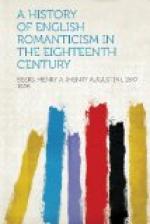Up to the last decade of the eighteenth century the romantic movement in Great Britain had been self-developed and independent of foreign influence, except for such stimulus as it had found, once and again, in the writings of continental scholars like Sainte Palaye and Mallet. But now the English literary current began to receive a tributary stream from abroad. A change had taken place in the attitude of the German mind which corresponds quite closely to that whose successive steps we have been following. In Germany, French classicism had got an even firmer hold than in England. It is well-known that Frederick the Great (1740-86) regarded his mother-tongue as a barbarous dialect, hardly fit for literary use. In his own writings, prose and verse, he invariably employed French; and he boasted to Gottsched that from his youth up he had not read a German book.[1]
But already before the middle of the century, and just about the time of the publication of Thomason’s “Seasons,” the so-called Swiss school, under the leadership of the Zuericher, Johann Jacob Bodmer, had begun a national movement and an attack upon Gallic influences. Bodmer fought under Milton’s banner, and in the preface to his prose translation of “Paradise Lost” (1732), he praised Shakspere as the English Sophocles. In his “Abhandlung von dem Wunderbaren” ("Treatise on the Marvelous,” 1740) he asserted the claims of freedom, nature, and the inspired imagination against the rules of French critics, very much as the Wartons and Bishop Hurd did a few years later in England. Deutscheit, Volkspoesie, the German past, the old Teutonic hero-age, with the Kaiserzeit and the Middle Ages in general, soon came into fashion. “As early as 1748 Bodmer had published specimens from the Minnesingers, in 1757 he had brought out a part of the Nibelungenlied, in 1758 and 1759 a more complete collection of the Minnesingers, and till 1781, till just before his death, he continued to produce editions of the Middle High-German poems. Another Swiss writer, Christian Heinrich Myller, a pupil of Bodmer’s . . . published in 1784 and 1785 the whole of the Nibelungenlied and the most important of the chivalrous epics. Lessing, in his preface to Gleim’s ‘War-songs,’ called attention to the Middle High German poets, of whom he continued to be throughout his life an ardent admirer. Justus Moeser took great interest in the Minnesingers. About the time when ‘Goetz’ appeared, this enthusiasm for early German poetry was at its strongest, and Buerger, Voss, Miller, and Hoeltz wrote Minnesongs, in which they imitated the old German lyric poets. In 1773 Gleim published ‘Poems after the Minnesingers,’ and in 1779 ’Poems after Walther von der Vogelweide.’ Some enthusiasts had already hailed the Nibelungenlied as the German Iliad, and Buerger, who vied hard with the rest, but without much success, in turning Homer into German, insisted on dressing up the Greek heroes a little in the Nibelungen style. He and a few




